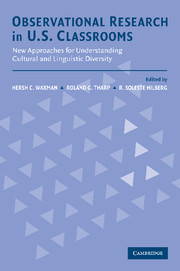 Observational Research in U.S. Classrooms
Observational Research in U.S. Classrooms Published online by Cambridge University Press: 23 November 2009
Systematic classroom observation methods have been widely used in the past several decades to investigate effective teaching practices (Brophy & Good, 1986; Stallings & Mohlman, 1988; Waxman, 1995; Waxman & Huang, 1999). One of the most important uses of the method has been to determine which teaching practices improve student learning (Waxman & Huang, 1999). Most classroom observation instruments typically focus on the teacher as the unit of measurement or observation, and thus they describe a variety of instructional behaviors in which teachers engage. There are limitations, however, with teacher-based classroom observation instruments. First, teacher-focused instruments suggest that teaching practices directly impact student outcomes, without acknowledging that student behaviors impact teacher behaviors as well. Another concern with teacher-focused observation systems is that they often ignore student behaviors that have a greater impact on student outcomes than teacher behaviors.
Another limitation of teacher-based observation instruments is that they generally do not allow researchers to examine individual student behaviors, particularly differences by critical attributes such as student sex, ethnicity, or grouping classification (e.g., gifted/nongifted, resilient/nonresilient, monolingual/bilingual). A final concern with teacher-centered observation systems is that they are often very threatening to classroom teachers. Many teachers are reluctant to volunteer to participate in classroom observation research because they know the focus of attention is on the teachers and their instructional practices.
This chapter describes the uses of a systematic classroom observation instrument, the Classroom Observation Schedule (COS), that was designed to address some of the previous concerns of classroom observation by specifically focusing on individual students rather than the teacher (Waxman, Wang, Lindvall, & Anderson, 1990a, 1990b).
To save this book to your Kindle, first ensure [email protected] is added to your Approved Personal Document E-mail List under your Personal Document Settings on the Manage Your Content and Devices page of your Amazon account. Then enter the ‘name’ part of your Kindle email address below. Find out more about saving to your Kindle.
Note you can select to save to either the @free.kindle.com or @kindle.com variations. ‘@free.kindle.com’ emails are free but can only be saved to your device when it is connected to wi-fi. ‘@kindle.com’ emails can be delivered even when you are not connected to wi-fi, but note that service fees apply.
Find out more about the Kindle Personal Document Service.
To save content items to your account, please confirm that you agree to abide by our usage policies. If this is the first time you use this feature, you will be asked to authorise Cambridge Core to connect with your account. Find out more about saving content to Dropbox.
To save content items to your account, please confirm that you agree to abide by our usage policies. If this is the first time you use this feature, you will be asked to authorise Cambridge Core to connect with your account. Find out more about saving content to Google Drive.